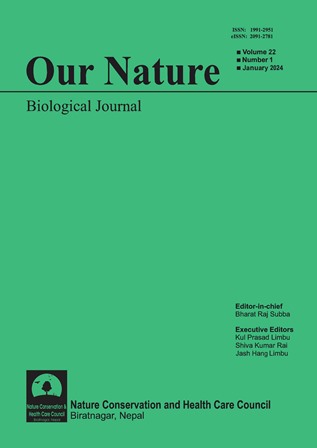Laetiporus sulphureus in the mid-hills of Central Nepal: ecology, ethnomycology and present status
DOI:
https://doi.org/10.3126/on.v22i1.67347Keywords:
Sulphur polypore, Rato chyau, Habitat, Edible mushroom, Traditional KnowledgeAbstract
Laetiporus sulphureus is a well-known edible mushroom with a high medicinal value. It is reported from different places in Nepal, particularly from mid-hill areas. However, the ecology and ethnomycology of L. sulphureus were poorly known in Nepal. We aimed to study the ecology, ethnomycology, and present status of L. sulphureus from the mid-hills of Dolakha district, central Nepal. The habitat of L. sulphureus in the six different sites of the study area was surveyed to find out the dominant tree species and microclimatic conditions. Additionally, a questionnaire survey was conducted to document ethnic knowledge and the status of L. sulphureus. We found dominance of tree species such as Tsuga dumosa, Quercus semicarpifolia, and Rhododendron arboreum in the habitat of L. sulphureus. Dead and decayed logs/trunk of these tree species were found to support L. sulphureus growth. Regarding microclimatic conditions, an average temperature of 20 °C, a light intensity of 1000–2000 lux, and relative humidity of 65–80% were recorded under the canopy where L. sulphureus was growing. Fruitbodies of L. sulphureus were found to be collected by local people for food and medicinal purposes. Local people were found to use dried L. sulphureus powder for the treatment of aliments such as diarrhea and hematochezia. The availability of L. sulphureus was found to be declining due to overharvesting, logging of the host tree, and the removal of coarse wood debris. Collection of L. sulphureus fruitbodies and logging of host tree should be regulated for its conservation in wild habitat. This study provides valuable information about the possible substrate types and environmental conditions that could be used for the successful domestication of L. sulphureus at the study sites and similar locations.
Downloads
Downloads
Published
How to Cite
Issue
Section
License
Copyright (c) 2024 The Author(s)

This work is licensed under a Creative Commons Attribution-NonCommercial 4.0 International License.
This license enables reusers to distribute, remix, adapt, and build upon the material in any medium or format for noncommercial purposes only, and only so long as attribution is given to the creator.




